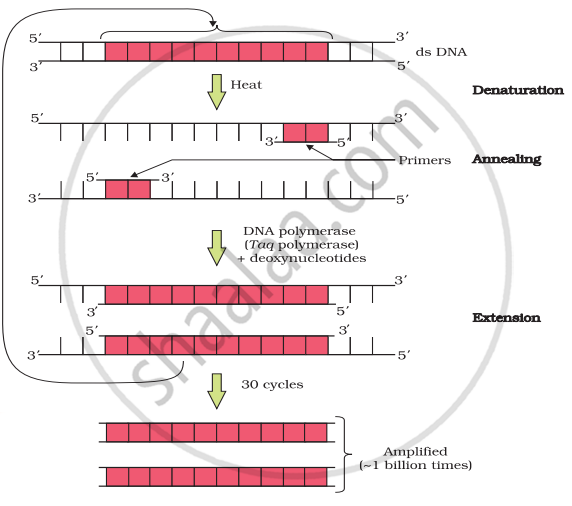Advertisements
Advertisements
प्रश्न
Explain briefly:
PCR
उत्तर
Polymerase chain reaction (PCR) is a technique for producing numerous copies of a desired gene (DNA) in vitro. Kary Mullis developed this approach in 1985. It is based on the fact that when exposed to high temperatures, a DNA molecule separates into two strands due to denaturation. These single-stranded molecules are subsequently transformed into double-stranded molecules by synthesising additional strands in the presence of the enzyme DNA polymerase. Repeating the process several times produces copies of the original DNA sequence. The basic prerequisites of PCR are a DNA template, two nucleotide primers (typically 20 nucleotides long), and an enzyme DNA polymerase that is stable at high temperatures (commonly Taq polymerase). The mechanism of PCR is as follows:
- First, the target DNA (DNA segment to be amplified) is heated to a high temperature (94-96° C). Heating separates two strands of DNA. Each of the two strands of target DNA now serves as a template for synthesising a new DNA strand. This procedure is known as denaturation.
- Denaturation is followed by annealing. During this stage, two oligonucleotide primers hybridise with each single-stranded template DNA in the presence of an excess of synthetic oligonucleotides. Annealing is done at a lower temperature (40° to 60°C).
- The third and last step is extension. In this stage, the enzyme DNA polymerase synthesises the DNA segment between the primers. Taq DNA polymerase, which was obtained from the thermophilic bacterium Thermus aquatics, is commonly utilised in most circumstances. The two primers extend towards each other to duplicate the DNA segment located between them. This phase requires the presence of deoxynucleoside triphosphates (dNTPs) and Mg2+ and takes place at 72°C.
The above three procedures finish the first PCR cycle. The second cycle begins with the denaturation of the previous cycle's extension product, and two cycles are finished after the extension phase is completed. If these cycles are performed several times, the DNA segment can be amplified roughly a billion times, yielding one billion copies of the target DNA segment.
APPEARS IN
संबंधित प्रश्न
Suggest and describe a technique to obtain multiple copies of a gene of interest in vitro.
Draw a labelled sketch of sparged-stirred-tank bioreactor. Write its application.
From what you have learnt, can you tell whether enzymes are bigger or DNA is bigger in molecular size? How did you know?
Can you recall meiosis and indicate at what stage a recombinant DNA is made?
Explain briefly:
Chitinase
Prepare a flow chart in formation of recombinant DNA by the action of restriction endonuclease enzyme EcoRI.
Answer the following question:
Describe the process of amplification of the "gene of interest" using the PCR technique.
DNA fragments generated by the restriction endonuclease in a chemical reaction can be separated by ______.
PCR and restriction fragment length polymorphism are the methods for ______.
Gene Amplification using primers can be done by ______.
PCR proceeds mthree distinct steps governed by temperature, they are in order of ______.
In addition to the Taq polymerase enzyme, which other thermostable DNA polymerases have been isolated to be used in PCR?
During the purification process for recombinant DNA technology, the addition of chilled ethanol precipitates out ______.
Rising of dough is due to ______.
An antibiotic resistance gene in a vector usually helps in the selection of ______.
Significance of 'heat shock' method in bacterial transformation is to facilitate ______.
Which of the following steps are catalysed by Taq DNA polymerase in a PCR reaction?
A bacterial cell was transformed with a recombinant DNA molecule that was generated using a human gene. However, the transformed cells did not produce the desired protein. Reasons could be ______.
Do biomolecules (DNA, protein) exhibit biological activity in anhydrous conditions?
Identify and explain steps ‘A’, ‘B’ and ‘C’ in the PCR diagram given below.

